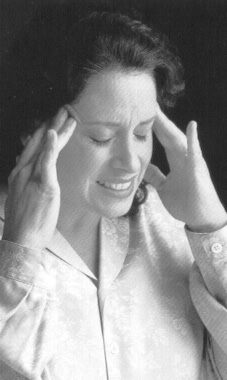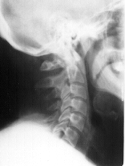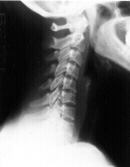 |
 |
| We treat the following conditions when related to functional problems of the neck and TMJ.
HEADACHES Headaches are the expression of the tremendous stress experienced by the muscles of the neck and delicate, pain sensitive coverings (meninges) of the spinal cord, brain stem and brain itself. Doctors have recently located connective tissue which travels from contracted muscle tissue in the upper neck to the delicate menigeal coverings. They now believe that muscular tension in the neck can be a trigger for severe migraine and cluster headaches. Few if any headache sufferers have a normal neck. Many have excessive muscular tension alone but the vast majority have a loss of normal spine posture. In the spine the neck has a natural forward curve of about 40 degrees. This insures proper balance of the head on the torso. But through injury, poor posture or birth defect the forward curve can become lost. This loss can even result from forceps delivery or birth trauma. Loss of the forward curve mean excess strain to the neck muscles and meninges and a lifetime of headaches can result. Obviously no medication will change posture or mechanical irritation of the neck. Many of us perform 8 hours of head flexed work like keyboarding, detailed hand work, accounting and other contemporary jobs, that evolution has not designed our bodies to handle. This is one way to lose one's forward neck curve. Another is trough injury such as whiplash, fall, deceiving a blow or even constant stomach sleeping or sleep during which too many pillows or supports are used. When placed under under extra stress, our response is to tighten the muscles of the neck and shoulder even more. This added tension on top of muscles which are normally irritated by abnormal spinal position can be the spark that leads to headache onset. When you have a headache, does your neck hurt? There is a connection. Injury and stress distort the mechanics of the spine and its muscular support system. medication may ease the pain but won't help the underlying mechanical problem. In
the Journal of the American Medical Association in 1998, a study of
tension type headache suffers was made, incorporating the participation
of 13,345 subjects from the community of Baltimore County,
Maryland. These 13,000+ subjects were evaluated using the guide
lines of the International Headache Society criteria for work days
lost, reduced effectiveness at work, home or Recent data reported in a study by Neilson and Christianson "The effective spinal manipulation in the treatment of cervical spine related headache. " in the Journal of Manipulative Physiological Therapeutics in 1997 indicated that chiropractic spinal manipulation has a significant positive effect in cases of headache. The implications are obvious. If according to the study reviewed, over 1/3 of the population suffers from a condition for which chiropractic care can have a significant positive effect, patients should be made aware of this. Private practitioners would be wise to spend considerable energy educating the public and their own patient base about the positive effects chiropractic care can offer for this very common problem. The study be Dr. Nielson demonstrated that when he compared the treatment of cervical spine manipulation versus simply doing soft tissue massage on neck muscles, there was a 36% decrease of headaches within 5 weeks on the part of individuals receiving spinal manipulation along with an intensity decrease rated at 36% of the headache suffers in the same group receiving manipulation of the cervical spine compared to a much lower value of only 17% receiving massage only. Also the duration of headaches per day was significantly lowered and decreased as much as 69% in the group receiving cervical adjustments as compared to 37% in the group receiving massage only. I have treated a number of people with chronic and sometimes lifelong migraine headache symptoms and obtained generally good response to care. By providing chiropractic manipulation and other therapies directed toward the cervical spine and by assessing biomechanics, nutrition and other factors in patients daily lives, my experience indicates that most tension and migraine sufferers can be treated successfully. MIGRAINE HEADACHES and MANIPULATIVE THERAPY: Two case studies. There is mounting evidence to demonstrate that faulty biomechanics due to misalignment of spinal vertebrae are a contributing factor in migraine headaches. Many researchers famous for their work including Bogduk, Stodolny, Schoensee and other medical doctors have demonstrated that limited motion of the cervical vertebrae were instrumental in the onset of migraine and other type headaches. 1. A 25 year old female presented for treatment complaining of migraine headaches for approximately 5 years. Her migraine symptoms were of a throbbing, continual pain that had become progressively worse over the past 4 months. Pain in the neck and upper back area also extended into the shoulders and accompanied her migraine symptoms. She commonly took pain relieving medication such as tricyclic anti-depressants for the chronic pain and migraine symptoms. Rest and a quiet, dark room did help to ease the pain. She was often incapacitated for long periods of time having missed many days of work and important occasions. In examining her cervical (neck) range of motion, it was seen that she had considerable tenderness in the spinal regions of the 2nd and 3rd cervical vertebrae as well as the 6th cervical through the 2nd thoracic vertebrae in the mid and upper back. Treatment consisted of spinal manipulation to alter or change the biomechanics of the individual segments or vertebrae that were deemed to be misaligned. |
|
|
||||||||||||||||||||||||||||||||
| Over
the next 4 months the patient received 10 manipulations or cervical
adjustments which reduced her migraine symptoms. With this start,
the patient received an additional 14 cervical adjustments over the
next 3 months. At the end of that time, the patient found that
she still had an occasional migraine headache, but was immediately
relieved by manipulation. She continued to take her over the
counter and prescriptive medication paliatively, but found a decreasing
reliance on them as her migraines abated significantly.
2. A 32 year old female who complained of migraine headaches and stiff neck for 12 years. Her history revealed that she had a trauma with a broken arm in 1972 following a motor vehicle accident. Her symptomotology included flashing lights with a visual aura before each headache. The pain that she related was a 7.5 on a 10 (most severe) pain scale. The headaches occurred most often in the early evening and were more frequent at the end of the week. Light stresses seemed to exacerbate them. She had been taking beta blockers, vaso constrictors and over the counter medications for migraine pain since January of 1997. Again, going to sleep in a dark, quiet area helped decrease the pain. Her neurological examinations were negative. Cranial nerves were intact. All other physical and orthopedics tests were normal. A visual postural check, revealed that she had a left lower shoulder, with a right head tilt. The doctor examining her cervical spine found that she had reduced range of motion of her 2nd cervical vertebrae. There was muscular tension and spasm throughout the neck and upper shoulder region, extending into the mid back area. Treatment consisted of spinal manipulation and lasted for 14 adjustments over a 2 1/2 month period. During that time, the patient suffered 2 additional migraine headaches that were relieved by manipulation and non prescription medication. Following that, she has been able to voluntarily discontinue her prescribed medication and after 3 months of care she continues to receive occasional adjustments of the neck but has had no more migraine headaches. She also states that she is able to cope with daily life stresses without precipitating a migraine headache. Although
these are only 2 of many documented cases off chiropractic care for
migraine headaches, I must say that they follow my general experience
with dealing with migraine pain sufferers over the years. I have
treated a number of people with chronic and sometimes lifelong migraine
headache symptoms and obtained generally good response to care.
By providing chiropractic manipulation and other therapies directed
toward the cervical spine and by assessing biomechanics, nutrition and
other factors in patients daily lives, my experience indicates that
most migraine sufferers can be treated successfully. |
|
[General Information] [Pinched Nerves and Organ Health] [Exercises] [To The Physician] [To The Employer] [To The Attorney] |
|
Warwick Chiropractic Center, 40 Maple Avenue, Warwick, NY 10990 Tel: 845-986-5500 Fax: 845-986-6627 |
 school,
and degree of pain. The results show that the overall prevalence
of episodic tension headache sufferers were 38.3% of the population.
Women had a higher prevalence in all age, race and education groups and
the prevalence peaked at the age of 30-39 years old with 42.3% of men
and 46.9% of women responding that they had episodic tension type
headaches. 8.3% of these individuals reported lost days from work
due to these headaches, while 46.6% reported decreased effectiveness at
work, home or school. To qualify for this study the patient
with episodic type tension headaches had to have multiple headaches per
month but less than 15 attacks per month. An average attack
duration had to last from 30 minutes to 7 days. Excluded in this
group were headaches of migraine type symptoms or features including
nausea, photophobia and phenophobia, painful response to light and
noise. The frequency reported in this article was rather
startling considering that 38.3% of those contacted had headaches that
fell within the definition of episodic, tension type headaches.
school,
and degree of pain. The results show that the overall prevalence
of episodic tension headache sufferers were 38.3% of the population.
Women had a higher prevalence in all age, race and education groups and
the prevalence peaked at the age of 30-39 years old with 42.3% of men
and 46.9% of women responding that they had episodic tension type
headaches. 8.3% of these individuals reported lost days from work
due to these headaches, while 46.6% reported decreased effectiveness at
work, home or school. To qualify for this study the patient
with episodic type tension headaches had to have multiple headaches per
month but less than 15 attacks per month. An average attack
duration had to last from 30 minutes to 7 days. Excluded in this
group were headaches of migraine type symptoms or features including
nausea, photophobia and phenophobia, painful response to light and
noise. The frequency reported in this article was rather
startling considering that 38.3% of those contacted had headaches that
fell within the definition of episodic, tension type headaches.
